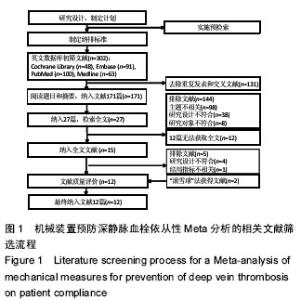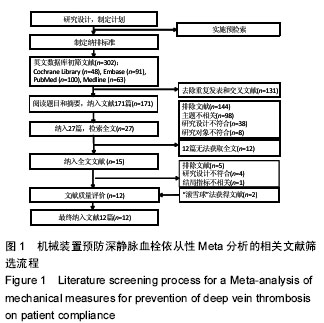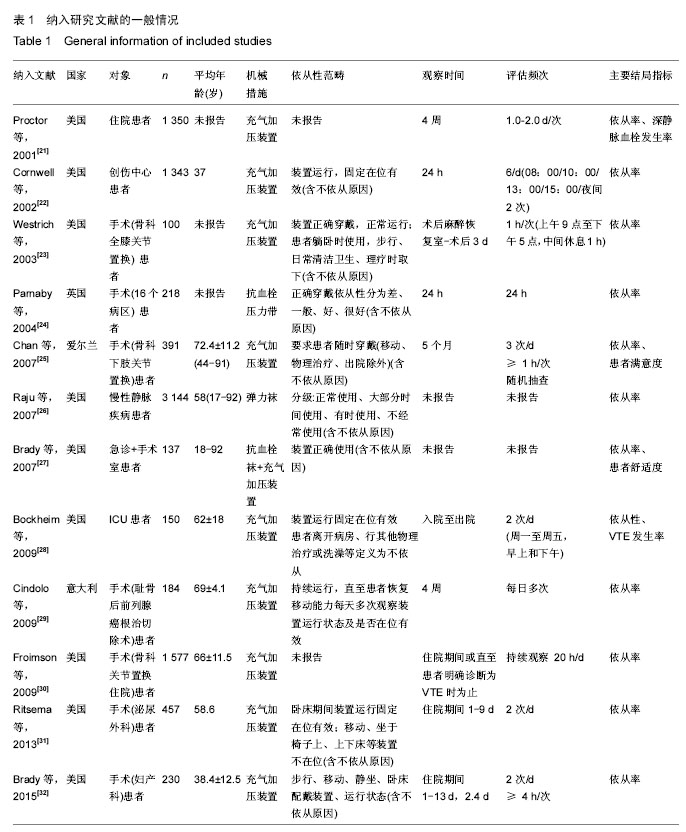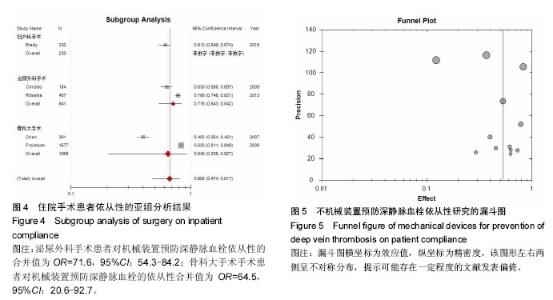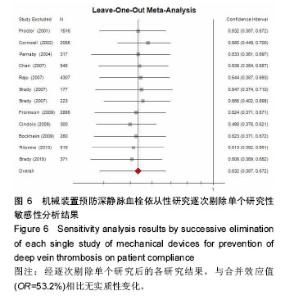Chinese Journal of Tissue Engineering Research ›› 2016, Vol. 20 ›› Issue (35): 5304-5312.doi: 10.3969/j.issn.2095-4344.2016.35.020
Previous Articles Next Articles
Mechanical device for prevention of deep vein thrombosis on patient compliance: a meta-analysis based on observational studies
Xie Yu1, Zhang Cheng-huan1, Liu Yun2
- 1School of Nursing, Nanjing University of Chinese Medicine, Nanjing 210000, Jiangsu Province, China; 2Health Technology Cadre Training Center, Nanjing University of Chinese Medicine Jinling Chinical School of Medicine, Nanjing 210000, Jiangsu Province, China
-
Revised:2016-06-13Online:2016-08-26Published:2016-08-26 -
Contact:Liu Yun, Master, Health Technology Cadre Training Center, Nanjing University of Chinese Medicine Jinling Chinical School of Medicine, Nanjing 210000, Jiangsu Province, China -
About author:Xie Yu, Studying for master’s degree, Primary nurse, School of Nursing, Nanjing University of Chinese Medicine, Nanjing 210000, Jiangsu Province, China -
Supported by:the Social Development-General Program of Science and Technology Department of Jiangsu Province, No. BE2015686
CLC Number:
Cite this article
Xie Yu, Zhang Cheng-huan, Liu Yun. Mechanical device for prevention of deep vein thrombosis on patient compliance: a meta-analysis based on observational studies[J]. Chinese Journal of Tissue Engineering Research, 2016, 20(35): 5304-5312.
share this article
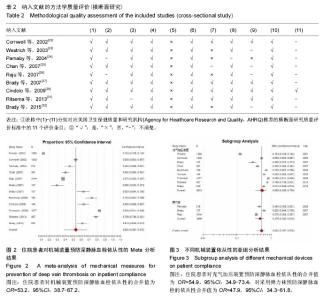
2.3 Meta分析结果 2.3.1 住院患者对机械装置预防深静脉血栓的依从性由于Brady等[27]研究中同时观察充气加压装置和弹力袜两种机械措施的依从性,故将此研究的数据提取分别纳入meta分析,而Westrich等[23]研究中,依从性的计算方法与其他研究有较大临床异质性故不纳入Meta分析。首先对纳入的文献进行异质性检验[16,33],提示研究存在统计学异质性(I2=49.8%,Q=0.999,P=0.000,故选用随机效应模型合并结果。Meta分析结果如图2所示,合并OR=53.2,95%CI:38.7-67.2,即住院患者对机械措施预防深静脉血栓的依从率为53.2%。 2.3.2 不同机械装置依从性的亚组分析 有11篇文献报道了不同机械装置预防深静脉血栓的依从性研 究[21-22,24-32],其中3篇关于弹力袜的研究[24,26-27],其他为充气加压装置。文献间比较有显著统计学异质性(合并值:I2=49.8%,弹力袜组:I2=48.7%,充气加压装置组:I2=49.8%,Q=0.999,P=0.000),均采用随机效应模型合并。meta分析结果显示见图3,使用弹力袜组合并OR=47.9,95%CI:34.3-61.8,即住院患者采用弹力袜预防深静脉血栓的依从率为47.9%;充气加压装置组合并值OR=54.9%,95%CI:34.9-73.4,即住院患者使用充气加压装置预防深静脉血栓的依从率为54.9%。2.3.3 住院手术患者依从性的亚组分析 有5篇文献报道了住院手术患者使用充气加压装置预防深静脉血栓时的依从性[25,29-32]。文献间存在统计学异质性(合并值 I2=49.7%,骨科大手术组I2=49.9%,泌尿外科手术组I2=48.4%,Q=0.997,P=0.000),采用随机效应模型合并。meta分析结果显示见图4,合并值OR=66.8%,95%CI:47.4-81.7,即住院手术患者对充气加压预防深静脉血栓的依从率为66.8%。其中骨科大手术患者合并依从率64.5%(OR=64.5,95%CI:20.6-92.7),泌尿外科手术依从率71.6%(OR=71.6%,95%CI:54.3-84.2),仅有1篇文献报告了妇产科手术患者依从率为61.3%[29]。 2.3.4 描述性分析结果:Westrich等[23]研究报道了行全膝关节置换术患者使用充气加压装置预防深静脉血栓的依从性,其依从性计算方式为观察时患者使用装置的总时间除以总共观察时间得出的结果,其他研究依从性计算方式为观察阶段内属于依从性范畴的使用机械装置的患者数目除以全部观察患者数目,依从性计算方式不同,故文章进行meta分析时,考虑其临床异质性与其他研究较大,分析时未将其纳入。 2.4 发表偏倚评价 采用Meta-analyst Beta3.13软件“Funnel plot”功能分析纳入的文献的发表偏倚(图5)。结果显示,左右两侧呈不对称分布,提示可能存在一定程度的发表偏倚。"
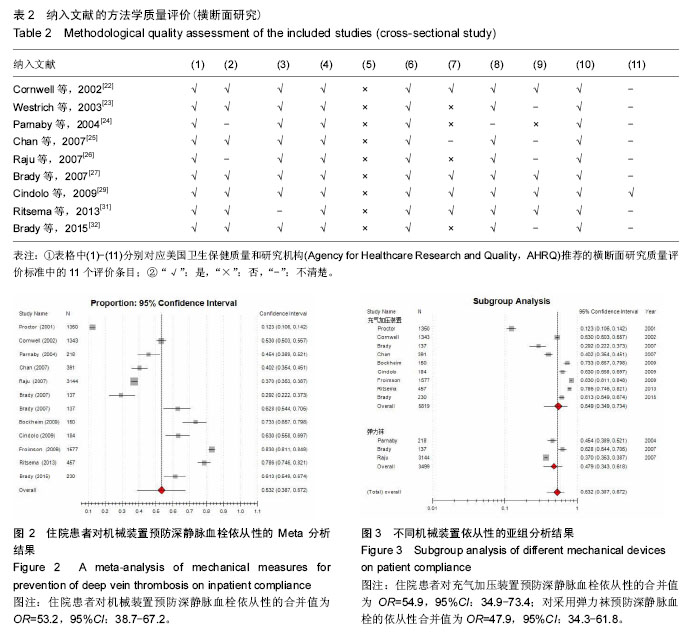
| [1] Santiago H, Comerota AJ. Embolization during treatment of deep venous thrombosis: incidence, importance, and prevention.Tech Vasc Interv Radiol. 2011;14(2):58-64. [2] 中华医学会骨科学分会.中国骨科大手术静脉血栓栓塞症预防指南[J].中华骨科杂志,2016,36(2):65-71. [3] Wade R, Sideris E, Paton F, et al. Graduated compression stockings for the prevention of deep-vein thrombosis in postoperative surgical patients: a systematic review and economic model with a value of information analysis. Health Technol Assess. 2015; 19(98):1-220. [4] Yngve FY, Francis CW, Johanson NA, et al. Prevention of VTE in orthopedic surgery patients: antithrombotic therapy and prevention of thrombosis, 9th ed: American College of Chest Physicians Evidence-Based Clinical Practice Guidelines. Chest. 2012;141(2):e278S-e325S. [5] Mont MA, Jacobs JJ, Boggio LN, et al. Preventing venous thromboembolic disease in patients undergoing elective hip and knee arthroplasty. J Am Acad Orthop Surg. 2011;19(12):768-776. [6] Pavon JM, Adam SS, Razouki ZA, et al. Effectiveness of intermittent pneumatic compression devices for venous thromboembolism prophylaxis in high-risk surgical patients: a systematic review. J Arthroplasty. 2016;31(2):524-532. [7] Pitto RP, Hamer H, Heiss-Dunlop W, et al. Mechanical prophylaxis of deep-vein thrombosis after total hip replacement a randomised clinical trial. J Bone Joint Surg Br. 2004;86(5):639-642. [8] Craigie S, Tsui JF, Agarwal A, et al. Adherence to mechanical thromboprophylaxis after surgery: A systematic review and meta-analysis. Thromb Res. 2015;136(4):723-726. [9] 杜世正.自我管理项目对慢性肌肉骨骼痛类疾病干预效果的系统评价研究[D].上海:第二军医大学,2011. [10] 胡雁.循证护理学[M].北京:人民卫生出版社,2012. [11] 刘鸣.系统评价、Meta-分析设计与实施方法[M].北京:人民卫生出版社,2011. [12] 曾宪涛,刘慧,陈曦,等.Meta分析系列之四:观察性研究的质量评价工具[J].中国循证心血管医学杂志,2012, 4(4): 297-299. [13] 张娟娟,汪东海,代继宏.大气可吸入性颗粒物暴露与儿童哮喘显著关联:基于22篇观察性研究的Meta分析[J].中国循证儿科杂志,2015,10(5):337-344. [14] Rostom A, Dube C, Cranney A, et al. Celiac Disease. Rockville (MD): Agency for Healthcare Research and Quality (US). 2004. [15] 王在标,尹慢慢,蔡慧,等.ABO血型与胃癌发生风险的病例-对照研究及meta分析[J].第二军医大学学报,2014,35(5):560-565. [16] 雷婷,马亚娜,聂宏伟,等.中国现阶段老年期痴呆患病率的Meta分析[J].现代预防医学,2012,39(4):809-814. [17] 虞涛,王旭,吴鉴今,等.利奈唑胺治疗耐多药结核病的疗效与安全性的Meta分析[J].中国药房,2014,25(8):731-735. [18] 翁鸿,鄢金柱,田国祥,等.牙周病与高血压发病相关性:一项基于观察性研究的Meta分析[J].中国循证心血管医学杂志,2015,7(1):16-19. [19] 罗杰,冷卫东.系统评价/Meta分析理论与实践[M].北京:军事医学科学出版社,2013:348-375. [20] B L, T W, Hn Z, et al. The prevalence of hyperuricemia in China: a meta-analysis. BMC Public Health. 2011; 11(24):2965-2966. [21] Proctor MC, Greenfield LJ, Wakefield TW, et al. A clinical comparison of pneumatic compression devices: the basis for selection. J Vasc Surg. 2001;34(3): 459-463. [22] Cornwell EE 3rd, Chang D, Velmahos G, et al. Compliance with sequential compression device prophylaxis in at-risk trauma patients: a prospective analysis. Am Surg. 2002;68(5):470-473. [23] Westrich GH, Jhon PH, Sánchez PM. Compliance in using a pneumatic compression device after total knee arthroplasty. Am J Orthop. 2003;32(3):135-140. [24] Parnaby C. A new anti-embolism stocking. Use of below-knee products and compliance. Br J Perioper Nurs. 2004;14(7):302-307. [25] Chan JC, Roche SJ, Lenehan B, et al. Compliance and satisfaction with foot compression devices: an orthopaedic perspective. Arch Orthop Trauma Surg. 2007;127(7):567-571. [26] Raju S, Hollis K, Neglen P. Use of Compression stockings in chronic venous disease: patient compliance and Efficacy. Ann Vasc Surg. 2007;21(6): 790-795. [27] Brady D, Raingruber B, Peterson J, et al. The Use of knee-length versus thigh-length compression stockings and sequential compression devices. Critl Care Nurs Q. 2007;30(3):255-262. [28] Bockheim HM, Mcallen KJ, Baker R, et al. Mechanical prophylaxis to prevent venous thromboembolism in surgical patients: a prospective trial evaluating compliance. J Crit Care. 2009;24(2):192-196. [29] Cindolo L, Salzano L, Mirone V, et al. Thromboprophylaxis in radical retropubic prostatectomy: efficacy and patient compliance of a dual modality. Urol Int. 2009;83(1):12-18. [30] Froimson MI, Murray TG, Fazekas AF. Venous thromboembolic disease reduction with a portable pneumatic compression device. J Arthroplasty. 2009; 24(2):310-316. [31] Ritsema DF, Watson JM, Stiteler AP, et al. Sequential compression devices in postoperative urologic patients: an observational trial and survey study on the influence of patient and hospital factors on compliance. BMC Urol. 2013;13(3):259-261. [32] Brady MA, Carroll AW, Cheang KI, et al. Sequential compression device compliance in postoperative obstetrics and gynecology patients. Obstet Gynecol. 2015;125(1):19-25. [33] 李昂.2010-2050年中国老年痴呆的预测研究[D].苏州:苏州大学,2015. [34] Comerota AJ, Katz ML, White JV. Why does prophylaxis with external pneumatic compression for deep vein thrombosis fail? Am J Surg. 1992;164(3): 265-268. [35] Obi AT, Alvarez R, Reames BN, et al. A prospective evaluation of standard versus battery-powered sequential compression devices in post-surgical patients. Am J Surg. 2015;209(4):675-681. [36] Vandenbroucke JP, von Elm E, Altman DG, et al. Strengthening the Reporting of Observational Studies in Epidemiology (STROBE): explanation and elaboration. Int J Surg. 2014;12(12):1500-1524. |
| Viewed | ||||||
|
Full text |
|
|||||
|
Abstract |
|
|||||
